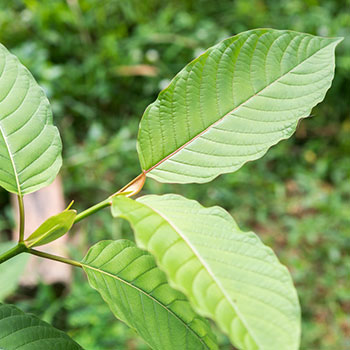Kratom (Mitragyna speciosa korth) is a tropical tree from Southeast Asia. Its leaves contain chemicals that can have mind-altering effects. In the U.S., kratom is sometimes marketed as a dietary supplement, but it’s often sold as a legal herbal drug in powder and capsule forms. It also can be prepared as a tea (the traditional method) or as an extract in some other liquid. Some people use it as an alternative treatment for conditions such as pain, anxiety, depression, and opioid use disorder. However, at this time, there are no FDA-approved uses of kratom.
Kratom has not been approved by FDA for any use and is on the DoD Prohibited Dietary Supplement Ingredients list.
Is kratom safe to use?
Kratom has numerous side effects, including nausea, vomiting, constipation, tremors, drowsiness, fatigue, insomnia, loss of sex drive, frequent urination, seizures, tachycardia (abnormally rapid heart rate), hallucinations, liver damage, and death. Kratom has also been found to be contaminated with opioids (such as hydrocodone, fentanyl, and O-desmethyltramadol), heroin, benzodiazepines, cocaine, heavy metals, and salmonella. One potent opioid-like chemical, 7-hydroxymitragynine, is present naturally in kratom at very low levels, but some kratom products have been found to contain much higher levels of this chemical than occurs in kratom naturally. This suggests a synthetic form of this chemical has been added to these products.
Kratom can be addictive. People using kratom might experience withdrawal symptoms such as muscle aches, insomnia, irritability, hostility, aggression, and jerky movements. Infants whose mothers use kratom during pregnancy also can become addicted, a condition known as kratom-associated neonatal abstinence syndrome.
Is kratom a controlled substance?
Currently, kratom is not a controlled substance, although the U.S. Drug Enforcement Administration (DEA) considers it a “drug of concern.” In countries where it is grown, it is chewed or made into a tea to counteract fatigue or reduce anxiety. The dose is important. At low doses it acts as a stimulant, but at higher doses it has opioid-like and psychoactive effects, which encourage its use as a recreational substance. However, it might also have potential therapeutic uses, and many users self-medicate with kratom to relieve opioid withdrawal symptoms, heroin and morphine addiction, and chronic pain. The conflict between the potential for abuse and this potential for therapeutic use has put a halt so far to making kratom a controlled substance. At this time, it is readily available online.
Federal agencies continue to investigate the effects of kratom, and DEA is still considering classifying the two major active substances in kratom—mitragynine and 7-hydroxymitragynine—as Schedule I controlled substances. For now, a number of states and cities have banned its use, and it is illegal in several countries, including those in which the plant is grown: Thailand, Malaysia, Myanmar, and Australia.
What is FDA’s stance on kratom?
FDA warns consumers not to use kratom. According to FDA:
- Kratom is not approved for use in dietary supplements. “FDA has exercised jurisdiction over kratom as an unapproved drug, and has also taken action against kratom-containing dietary supplements.”
- Kratom often is marketed as a “safe” treatment for some serious health conditions, but kratom contains compounds that “make it so it isn’t just a plant – it’s an opioid.”
- FDA has concerns about “kratom’s potential for abuse, addiction, and serious health consequences; including death.” In fact, there has been an increase in reported deaths associated with kratom use since November 2017.
- FDA has a well-developed process for evaluating botanical drug products, but “To date, no marketer has sought to properly develop a drug that includes kratom.”
Will kratom affect a drug test?
Kratom use will not produce a positive result on a routine DoD drug test. Regardless, Service Members are prohibited from using any product containing kratomas it is on the DoD Prohibited Dietary Supplement Ingredients list.
For more information about kratom, please see:
- FDA’s online article from 11 September 2019: “FDA is actively evaluating all available scientific information on this issue and continues to warn consumers not to use any products labeled as containing the botanical substance kratom or its psychoactive compounds, mitragynine and 7-hydroxymitragynine.”
- FDA’s statement from 25 June 2019: “FDA issues warnings to companies selling illegal, unapproved kratom drug products marketed for opioid cessation, pain treatment and other medical uses.”
- FDA’s statement from 27 November 2018: “… risk of heavy metals, including nickel and lead, found in some kratom products.”
- FDA’s News Release from 21 February 2018: FDA oversees destruction and recall of kratom products…
- FDA’s statement from 6 February 2018: “…scientific evidence on the presence of opioid compounds in kratom…”
- FDA’s statement from 14 November 2017: “… FDA advisory about deadly risks associated with kratom”
- The Drug Enforcement Administration’s Drugs of Concern fact sheet on kratom
- The National Institute on Drug Abuse fact sheet on kratom
Updated 07 March 2022

